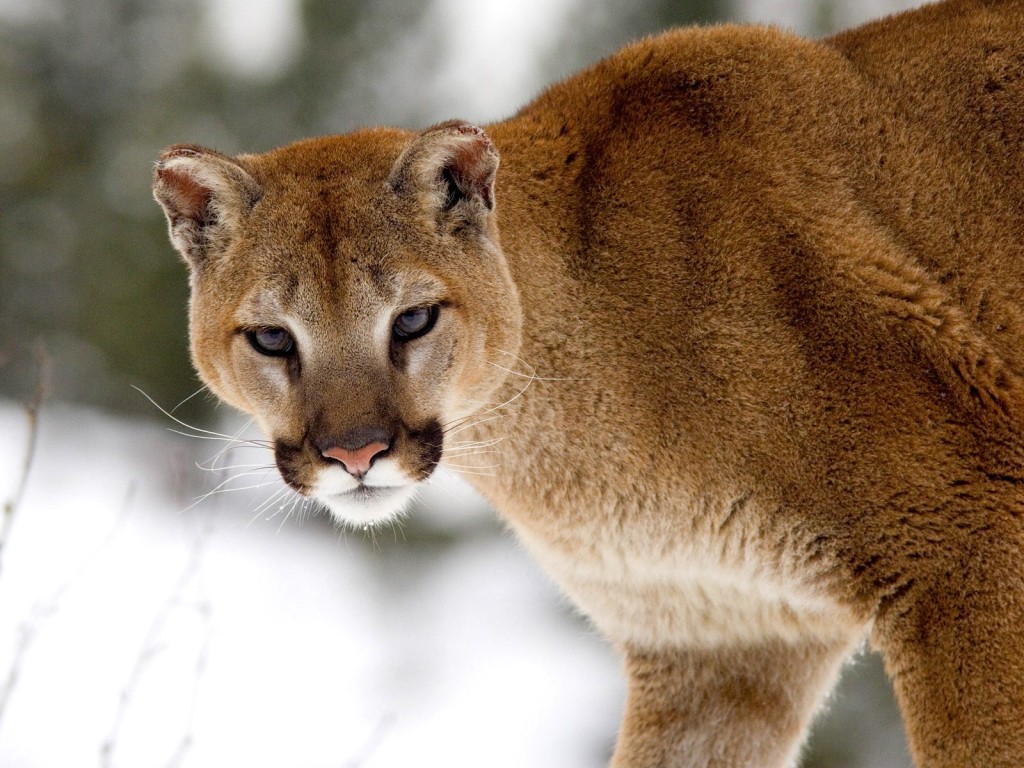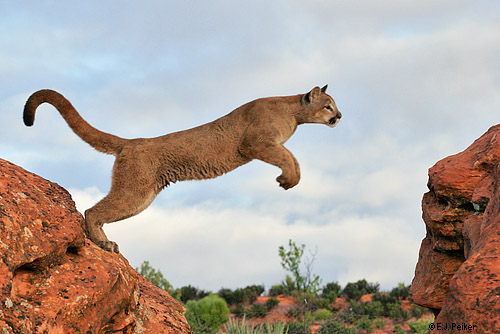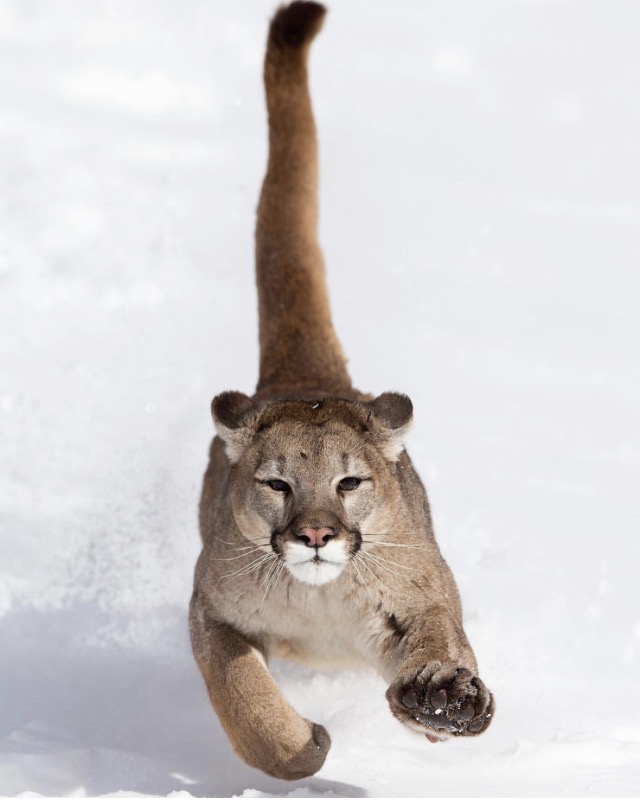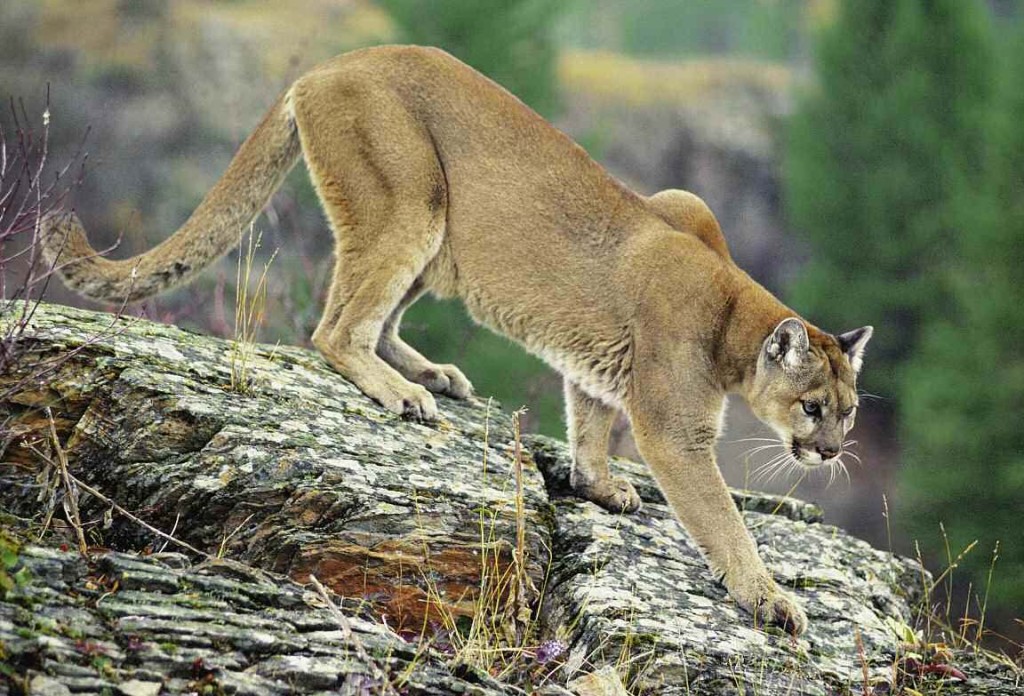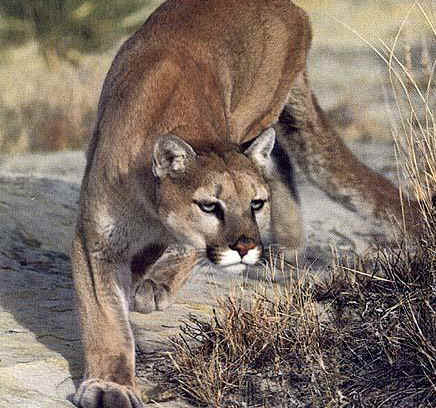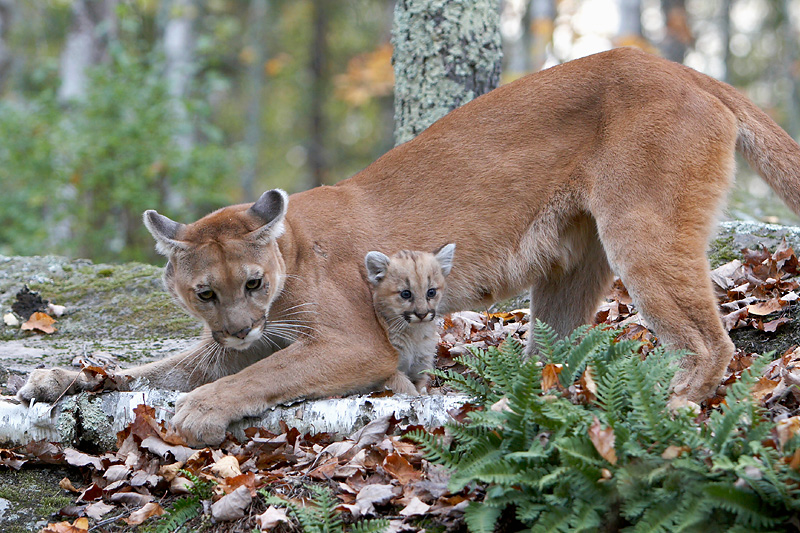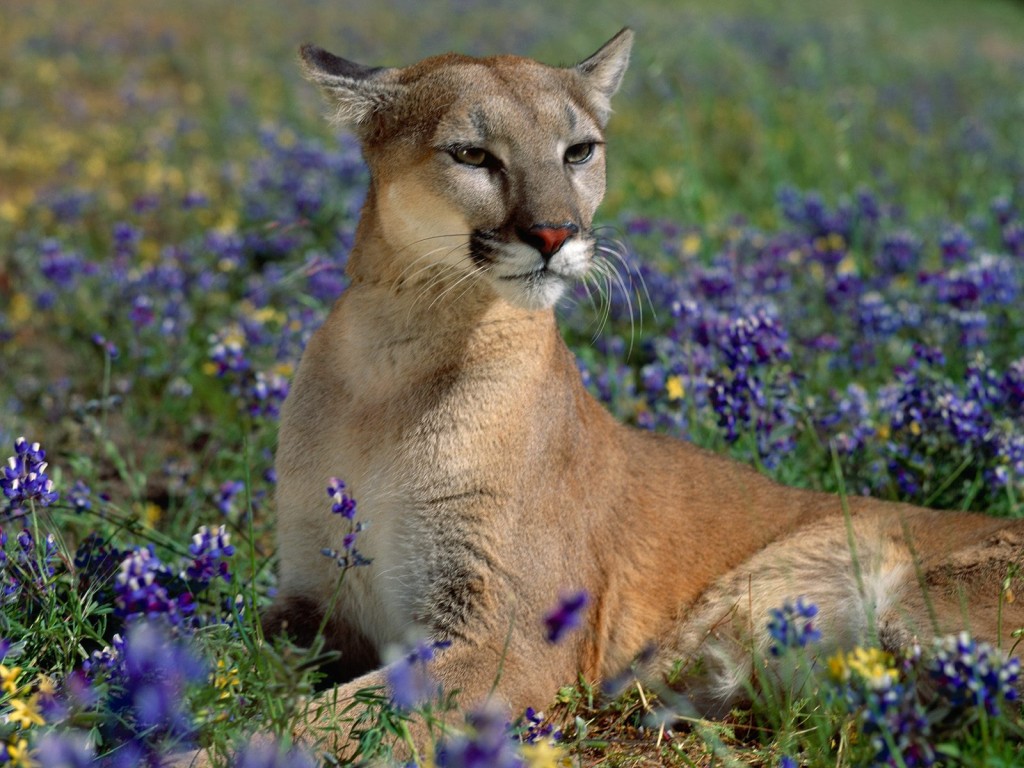The Puma
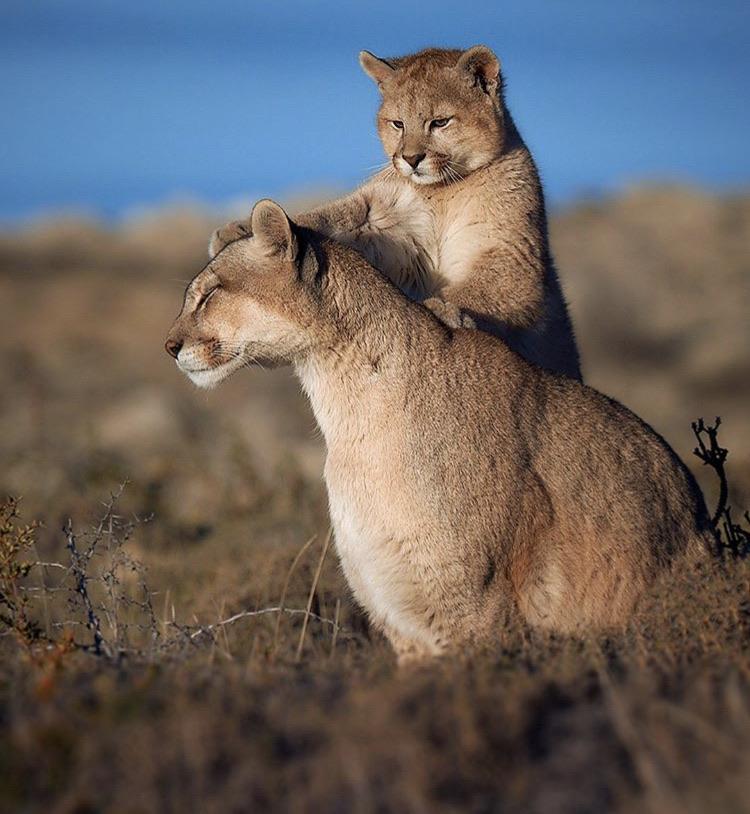
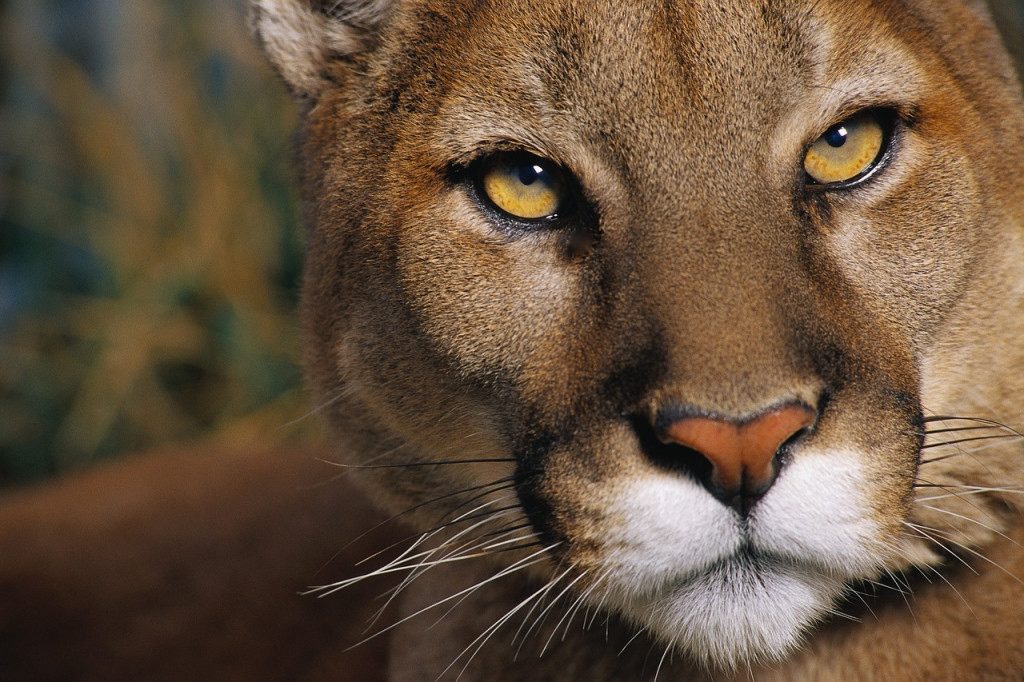
Puma
Kingdom: Animalia
Phylum: Cordata
Class: Mammalia
Order: Carnivora
Family: Felidae
Subfamily: Felinae
Genus: Puma
Species: Puma concolor
Puma conservation status: http://www.iucnredlist.org/details/18868/0

The Puma has many other additional names including Mountain Lion, Cougar, Panther, and Catamount. The Puma’s range is the greatest of any large wild terrestrial mammal in the Western hemisphere: from the northern Yukon in Canada to the southern Andes In South America. It is one of only three cat species, along with the Bobcat and Canada Lynx that is native to Canada.
The Puma prefers habitat with lots of underbrush and tree cover as well as steep canyons and rocky escarpments for stalking and ambush purposes but it will also live in wide open spaces too. It adapts to almost every habitat: it is found in tropical rainforests, temperate rainforests (which are the coniferous forests found in the Pacific Northwest), temperate deciduous forests (these are forests where the leaves change color), and in boreal forests (also known as taiga forests; they’re the coldest forests up in the northernmost countries and are mostly coniferous.) The Puma also thrives in lowland and mountainous deserts.
Pumas weigh from 29-100 kg (64-220 lb). There are some enormous males that can weigh around 136 kg (300 lbs)! The Puma is the fourth heaviest cat, after the Tiger, Lion, and Jaguar. Pumas can be almost as large as Jaguars, but are less muscular and not as powerfully built; and where their ranges overlap, the Puma tends to be smaller than average. Puma size is smallest close to the equator, and larger towards the poles.
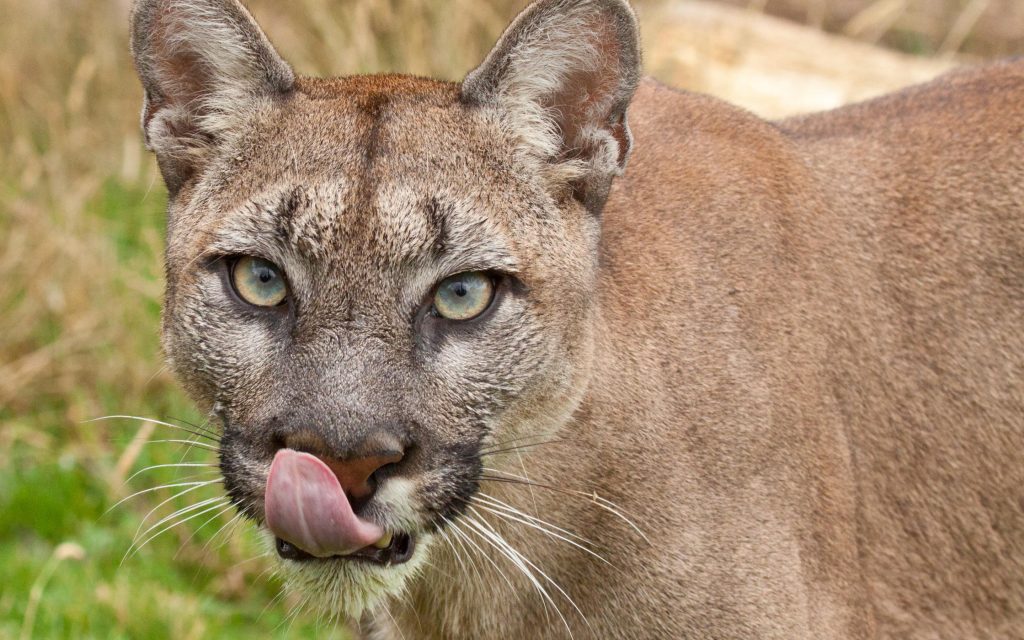
Pumas are gorgeous. Most have beautiful pale tawny yellow fur and tan yellow eyes. Some have crystalline blue eyes. There are people who claim to have seen Pumas in a melanistic phase (all black fur) but it has never been officially documented (note: when a Jaguar or Leopard is all black or melanistic it is often referred to as a black panther).
Pumas have large paws and proportionally, the largest hind legs in the cat family. These legs allow it to make great leaps and short-sprints. The Puma is able to leap as high as 5.5 m (18 ft) in one bound, and as far as 12-13.5 m (40-45 ft) horizontally.
The Puma’s top running speed ranges between 64-80 kmph (40-50 mph), but is best adapted for short, powerful sprints rather than long chases. It is adept at climbing, which allows it to evade wolves. Although it is not strongly associated with water, it can swim.
The Puma’s closest relative is the Jaguarundi. The Puma cannot roar as it lacks the specially evolved larynx and hyoid bones required to do so. But it can purr and it can also make little chirps and whistles, imitating bird calls which lures birds closer to them.
Pumas eat many herbivores who have seeds in their stomachs and because Pumas leave their scat (wild animal feces) across a large range, they are able to plant around 94,000 plants a year.
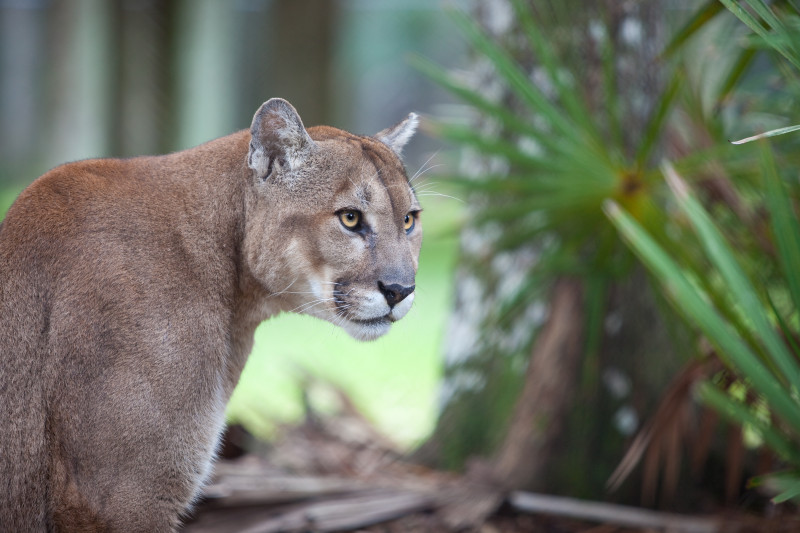
The Puma is very secretive and solitary by nature, and is nocturnal and crepuscular (this means a twilight and early dawn dweller) but daylight sightings do occur. It is incredibly shy around humans and the sighting of a Puma is a rare and great thing. There are people who have lived in Puma country their whole lives and never caught a glimpse.
Parenting
Only females are involved in parenting. Female Pumas are fiercely protective of their cubs, and have been known to successfully fight off animals as large as American Black Bears in their defense. Litter size is between one and six cubs, typically two. Caves and other alcoves that offer protection are used as litter dens.
Born blind, the cubs are completely dependent on their mother at first, and begin to be weaned at around three months of age. As they grow, they begin to go out on short trips with their mother, first visiting kill sites, and after six months beginning to hunt small prey on their own. When Pumas are born, they have spots, but they lose them as they grow and by the age of 2 1/2 years, the spots are completely gone.
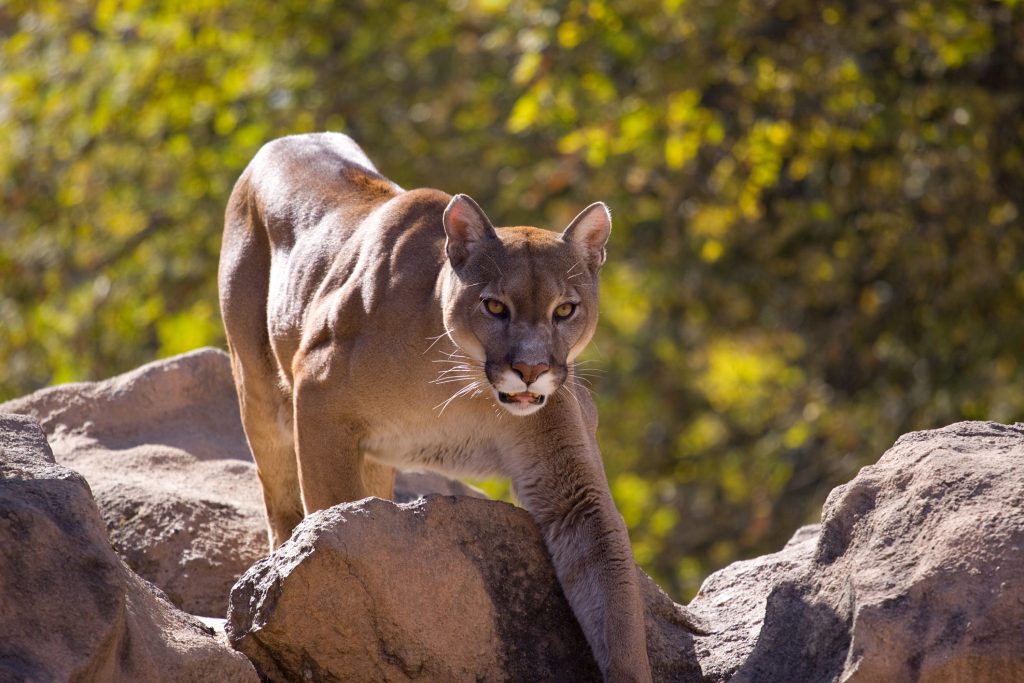
Longevity
Life expectancy of Pumas in the wild is reported at 8-13 years; but some may live much longer. One male North American Puma named Scratch was two months short of his 30th birthday when he died in 2007.
The Puma is a stalk and ambush predator, meaning instead of chasing its prey (which it still occasionally does), it prefers to wait in the shadows from above, sneaking up through brush and trees and across ledges, before leaping onto the back of its prey and a delivering a suffocating neck bite. Their prey die very quickly and relatively painlessly.
The Puma eats deer, elk, moose, and bighorn sheep, domestic cattle, horses, sheep, and also insects, small rodents, and reptiles. Like all cats, it is an obligate carnivore, meaning it needs to feed exclusively on meat to survive. It isn’t always the apex predator of its range (the apex predator is the top predator at the very pinnacle of the ecosystem’s food chain.) The Puma will yield to the Jaguar, the Wolf, the American Black Bear, and the Grizzly Bear.
Pumas Do Not Pose A Serious Threat To Livestock Numbers
It is a myth that Pumas pose a serious threat to livestock. A new 2013 study came out showing that unless a particular Puma is a major problem, it is better to just leave them alone because hunting them removes older Pumas who have learned to avoid people in their established territories. This allows inexperienced younger males who are most likely to approach human developments to enter the former territories of the older animals.
The results of the study:
-100% removal of adult Pumas resulted in a 150% – 340% increase in livestock and human conflicts!
-So, it is much better to leave the older adult experienced Pumas alone- virtually no livestock loss occurs this way.
Study: http://journals.plos.org/plosone/article?id=10.1371/journal.pone.0079713
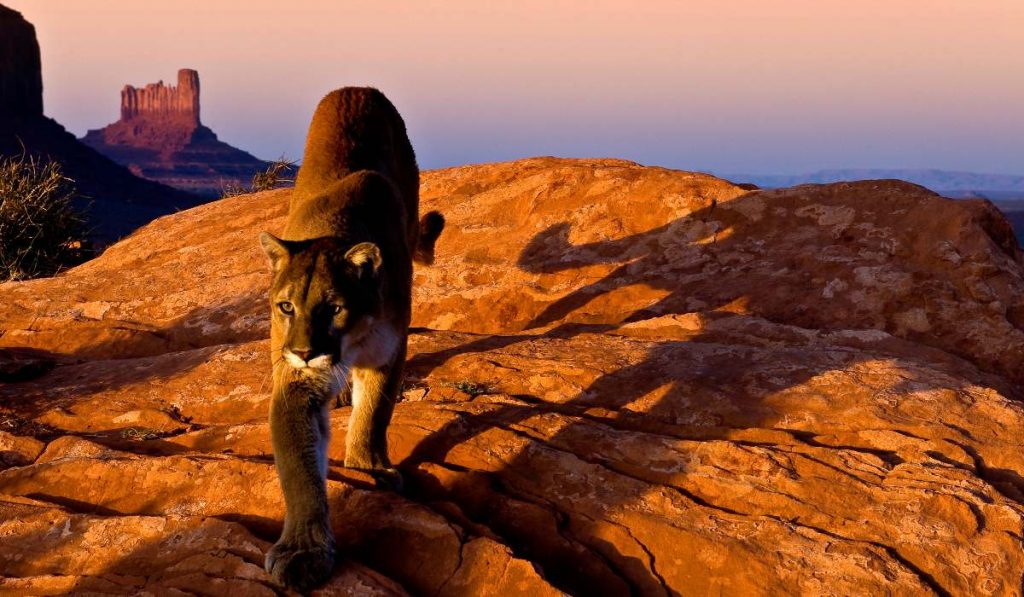
Pumas Are Vital For A Healthy Ecosystem
Pumas serve a major role in keeping the ecosystem healthy. They weed out the sick and genetically weak animals, keeping the populations in balance and healthy- which is turn keeps the vegetation and landscape healthy. Pumas are necessary for a healthy ecosystem.
Wildlife corridors and sufficient range areas are critical to the sustainability of Mountain Lion populations. A wildlife corridor is an area of habitat connecting wildlife populations that have become separated by human activities or structures, such as roads, development, or logging. It is an undisturbed land that animals can use to travel to different locations for water, food, and to breed. This allows an exchange of individuals between populations, which majorly helps prevent the negative effects of inbreeding and the reduction of genetic diversity.
Wildlife bridges also are critical to maintaining the health of wild animal populations. Wildlife bridges are bridges (or sometimes tunnels) that are built over or under busy roads and freeways so that animals can cross them.

Great News: Los Angeles is building the world’s largest wildlife bridge! It crosses a 10-lane freeway and it will save the Mountain Lion population by allowing cats to move through territory, thus increasing genetic diversity: https://kimcampion.com/awesome-nature/mountain-lion-wildlif-bridge-fully-funded/

Wildlife bridges reduce animal collisions with vehicles by 80 to 95 percent- this saves wild animal lives but also countless human lives. And not as importantly but still an issue: they save money too. Above is a famous wildlife bridge in Banff National Park in Canada.

“Though many biologists and citizens were skeptical of the wildlife bridges when they were first built, the six overpasses and 38 underpasses that criss-cross the Trans-Canada are today considered a worldwide conservation success story, reducing wildlife collisions by 80 per cent and buoying Banff biologists to rock-star status in the realm of transportation ecology. ” https://www.canadiangeographic.ca/article/banffs-famed-wildlife-overpasses-turn-20-world-looks-canada-conservation-inspiration

Hunting Pumas Must Be Federally Banned
It should be illegal everywhere to hunt Pumas. In some areas of the Americas, hunting of Pumas is prohibited but in many places they are bounty hunted and trapped. Pumas are generally hunted with packs of dogs, until the animal is ‘treed’. When the hunter arrives on the scene, he shoots the cat from the tree at close range. This is wrong. Trapping is also cruel and results in mutilation and long, painful deaths.
More Info:
https://www.all-creatures.org/articles/ar-victims-of-vanity-for-fur.html
https://www.nationalgeographic.com/news/2016/01/160115-bobcat-fur-trapping/
http://balancedecology.org/MountainLionWebSite/Mountain_Lion_Conservation_Project.html

Puma Attacks Are Incredibly Rare, But Just In Case, Here’s What To Do
Attacks on humans are very rare, as Puma prey recognition is a learned behavior and they do not generally recognize humans as prey unless they have become habituated to humans or are in a state of extreme starvation. Attacks are most frequent during late spring and summer, when juvenile Pumas leave their mothers and search for new territory. Fatal Puma attacks are extremely rare and occur much less frequently than fatal dog attacks, fatal snake bites, fatal lightning strikes, or fatal bee stings. Around 20 people in North America were killed by Pumas between 1890 and 2011, including six in California. More than two-thirds of the Canadian fatalities occurred on Vancouver Island in British Columbia where Puma populations are high.
As with many predators, a Puma may attack if cornered or if a fleeing human stimulates their instinct to chase. A person “playing dead” or simply standing still however may cause the Puma to consider a person easy prey. Here’s what to do if you see a Puma in the wild:
1.Make yourself appear as large as possible. Make yourself appear larger by picking up your children, leashing pets in, and if possible standing close to other adults. Open your jacket. Raise your arms. Wave your raised arms slowly.
2.Make noise. Yell, shout, bang your walking stick against a tree. Make any loud sound that cannot be confused by the Puma as the sound of prey. Speak slowly, firmly and loudly to disrupt and discourage predatory behavior.
3. Act like a predator yourself. Maintain eye contact. Never run past or from a Puma. Never bend over or crouch down. Aggressively wave your raised arms, throw stones or branches, all without turning away.
4. Slowly create distance. Assess the situation. Consider whether you may be between the Puma and its kittens, or between the Puma and its prey or cache. Back slowly to a spot that gives the Puma a path to get away, never turning away from the animal. Give the Puma the time and ability to move away.
5. Protect yourself. If attacked, fight back. Protect your neck and throat. People have utilized rocks, jackets, garden tools, tree branches, walking sticks, fanny packs and even bare hands to turn away Pumas.
More wild cats here
